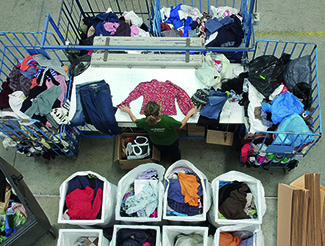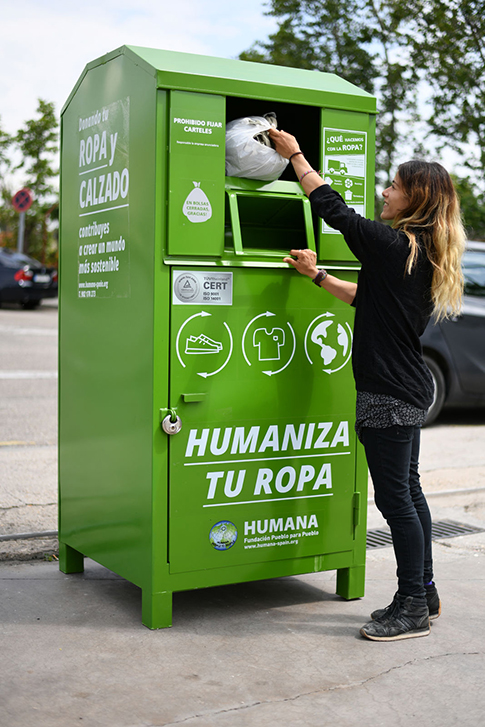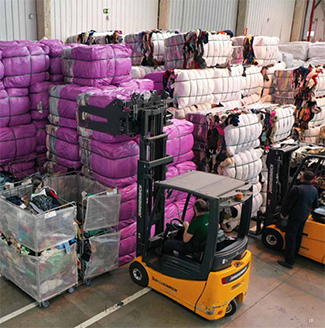consent_cookie
Duración: 1 year
Stores the user's cookie consent state
17-05-2019
Spain must recycle 50% of its domestic waste by 2020 but currently it only reaches 34%. The situation is more alarming in the case of textiles: Brussels also imposes reaching 50% a year ago, however only one out of every ten pieces discarded annually is recovered. While other urban waste has grown in its percentages of recovery, the textile is the forgotten one of the administrations. Installing more containers on public roads is the most urgent measure to avoid that every year 900,000 tons of clothes end up unused in landfills.
Although most of the garments we discard are likely to have a second life, only 10% is selectively recovered by an authorized manager to promote its reuse or recycling. The rest ends up in landfills where it is buried or incinerated. If this data is worrisome, it is aggravated by the fact that textile waste is the fifth most generated fraction (after organic, packaging and plastics, paper and cardboard, and glass), and the one that presents the percentage of higher valuation, above 90%.
On World Recycling Day, which takes place today, Friday May 17, Humana recalls the urgency of raising awareness among administrations and citizens about the importance of selective collection and not falling into the tail of the European Union on waste. This day invites reflection around recycling and reuse, through which waste is converted into resources if it is selectively recovered by authorized managers. Every time it is recycled and reused, it contributes to the protection of the environment; the useful life of the products is extended and, when this is finished, they are reintroduced into the market assuming the logic of the circular economy; Greenhouse gas emissions are reduced, and jobs are created in the so-called "green sector".
"When more than 90% of textile waste is wasted, although it is in good condition, and only one out of every ten garments is deposited in an authorized collection point, it is necessary to act without delay", says José David Moreno, Promoter National of Humana. From this entity they bet to implement an adequate network of containers in the municipalities: there should be a textile collection point for every 250-500 inhabitants to achieve the objectives imposed by the European Framework Directive, but the current ratio is one for every 3,000 -5,000 at best.
Another factor to improve: citizens are more likely to deposit waste in the appropriate container if they have it nearby. Considering the density of the population and the type of housing, the optimal distance between the user and a container must be less than 100 meters. "Unfortunately, in the case of textiles, this distance is not even remotely met," says José David Moreno, "it is an added difficulty to increase the selective collection of this fraction".
Brussels warns Spain
"Spain has made considerable progress in terms of circular economy," the European Commission grants in its report "Review of the application of EU environmental legislation, dated last month," but does not take full advantage of the opportunities to prevent and recycle waste. Since 2010, Spain has only slightly increased its recycling percentages. It must make a much greater effort to recycle 50% of municipal waste by 2020. Likewise, for the subsequent period, it must do even more to meet the new objectives of recycling ", which reach 55%.
The Waste Framework Directive establishes that prevention, including the reuse and lengthening of the life of products, is the priority strategy in the hierarchy of waste management, ahead of recycling, recovery and disposal. Hence the importance of raising public awareness of the need, options and opportunities to extend the useful life of resources and products, including prevention and reuse strategies.
The textile collection in Spain
As a specialist in preparation for reuse, Humana manages donations of clothing and footwear used by citizens to make the most of the textile waste, giving it a second life and favoring the circular economy. So far this year, from January to April, has recovered 4,112 tons, is equivalent to prolong the life cycle to 8.5 million garments. In addition, they represent a saving of 13,062 tons of CO2 to the atmosphere, something that the Planet is grateful for. Always, also, with the aim of giving a social purpose to the whole process.


